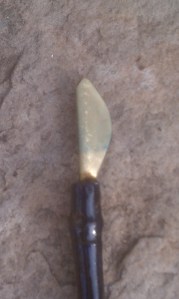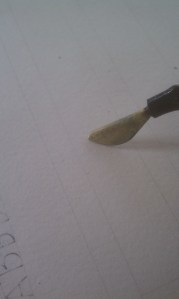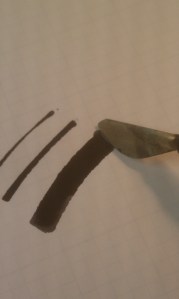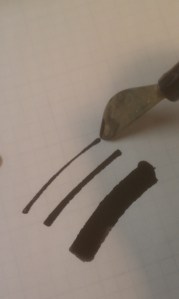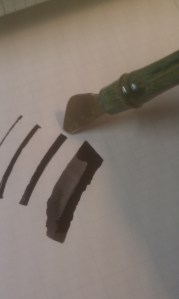Craftsmen who make their own tools are to be admired and emulated.  From woodworkers and stained glass artists to grandpa George who made screwdrivers out of bicycle wheel spokes in the 1920’s for his typewriter repair business, special tools are invented by creative people to solve specific problems. Lettering artists have made a variety of tools including brass, aluminum, balsa wood and cola can pens to all manner of extraordinary brushes to create special effects.
From woodworkers and stained glass artists to grandpa George who made screwdrivers out of bicycle wheel spokes in the 1920’s for his typewriter repair business, special tools are invented by creative people to solve specific problems. Lettering artists have made a variety of tools including brass, aluminum, balsa wood and cola can pens to all manner of extraordinary brushes to create special effects.
By far the most versatile tools I have created for making abstract marks are bristle-broom brushes like the two shown on the left. Rather than being fed, these brushes are designed to be dipped into a writing fluid. These brushes are almost as thirsty as old uncle Guido. He’s a great guy but keep him away from the Ouzo unless you want him dancing on your table with a lampshade on his head.
The variety of designs seems endless. I have made them fat and skinny, with long bristles and short, and with different types of bristles.
 Both of these brushes are made with broom bristles. The one on the right I made in an experimental lettering class almost 10 years ago. I simply taped the bristles to a stick with masking tape. I still use it, but it isn’t pretty.
Both of these brushes are made with broom bristles. The one on the right I made in an experimental lettering class almost 10 years ago. I simply taped the bristles to a stick with masking tape. I still use it, but it isn’t pretty.
The brush on the left is a bristle brush with a more refined handle. Theoretically it can take more abuse and has a nicer appearance. The handle is bamboo which has been painted with acrylic and sealed with polyurethane. The bristles are epoxied into the handle.
The bristles in these pens are short. In other prototypes I made the bristles longer so I could trim them as necessary. I also make the bristle length more uneven because it makes more interesting lines.
The flag end of the bristle was used as the writing surface for the pen on the left. The flag end is the portion of the bristle that comes in contact with the floor. Note how fuzzy the end is. It is softer and more pliable than any other part of the bristle. I used a different type of bristle as well. Flag end brushes make fuller, smoother marks. The brushes hold a lot of fluid.
Regardless of how the brush is made, loading, pressure, stroke length, brush angle and direction will determine the level of abstraction in the stroke. Theses tools are fun because there are so many ways to handle them that they always provide a new adventure in mark making.
Marks can be made with the bristles at any angle to the writing surface. Stiffer bristles at a ninety degree angle will spatter the most, providing a unique effect that works well on Tyvek sink-art.
 This image was created with a synthetic brush with two flag-end bristles.
This image was created with a synthetic brush with two flag-end bristles.
In general, the body of a bristle brush is stiff and coarse. Longer bristles hold more fluid and make fuller marks at the beginning of the stroke but the marks eventually develop their characteristic broken and intermittent appearance,. Brushes with more and longer bristles allow for larger marks, but ultimately a brush with fewer or shorter bristles will make the same kind of marks.
The abstract image below was created using a short bristle brush. The image now serves as my banner image. This is a slice of an image that is 8″ x 9″.
Synthetic bristles are pliable and spatter less than standard bristles, so once again the character of the line will be affected. Bristle brushes are so versatile and forgiving that many calligraphers , disciplined in making classical marks, have an adjustment time for the new-found freedom of using a bristle brush. Indeed the process of letting go of the need to control the marks presents considerable opportunities to learn and grow.
A great warm-up exercise is to make large sweeping marks on a sheet of newspaper. I use left over paint mixed together in a bottle deep enough to fully dip the brush into. It is essentially wash water. I make the largest mark that the brush will allow to get used to what it will do. Then I make small marks, jamming the brush onto the paper at a steep angle so it spatters.
Make a mess! The newspaper and paint are meant to be thrown away so your internal critic will not holler at you for being wasteful. You can have fun without guilt. What religion would not condone that?
Folded brass pens are versatile tools that make nice marks. I had this goofy idea to make a pen with two writing surfaces; one wide and one narrow with a ratio of 2:1….ish. I set out to hand fabricate a prototype and made several with different proportions. It’s sickness I say. I had so many ideas for nib angle, width and size that I reverted to making prototypes out of card stock.
The pens actually have three effective writing surfaces as you can see from the following images. The hand-fabricated nibs are set into bamboo handles.
Let the record show that I said the ratio is 2:1 “ISH”. These are prototypes after all.
I am currently experimenting with the size of the reservoir. There is a theoretical limit of nib width vs. mark length vs. reservoir capacity. How big can the reservoir be without unloading the entire contents of the nib at once? How long can a wide line be and how long is long enough?
 These are examples of several more mark making tools that I’ve been experimenting with. They all have bamboo handles that are painted in acrylic and sealed with polyurethane. Two of the nibs are balsa wood, two are bristle. The pen on the right has two mark making implements. One is a portion of wooden dental pick and the other side is made with cocktail straws with 1/8 inch slits in the ends.
These are examples of several more mark making tools that I’ve been experimenting with. They all have bamboo handles that are painted in acrylic and sealed with polyurethane. Two of the nibs are balsa wood, two are bristle. The pen on the right has two mark making implements. One is a portion of wooden dental pick and the other side is made with cocktail straws with 1/8 inch slits in the ends.
Epoxy was moved around all of the bristles, creating a waterproof seal. The brush will spatter less than the coarser version.
 I made a cola pen in an experimental lettering class, but didn’t like it. It was weak, bent over when I tried to write with it and seemed like more trouble that it was worth. I recall taping the nib to a stick. It was altogether unimpressive.
I made a cola pen in an experimental lettering class, but didn’t like it. It was weak, bent over when I tried to write with it and seemed like more trouble that it was worth. I recall taping the nib to a stick. It was altogether unimpressive.
I remained intrigued about cola pens because I’ve seen marvelous effects created with them. So, I created a cola pen that is an inch long with a half inch shank. The smaller nib size seems to help the pens’ stability. I epoxied the nib into a bamboo handle to make it stable.
I have a lighter hand these days, I’m not the ape I once was, The nib no longer bends under my heavy hand. Using the rounded edge of the pen makes the nib chatter, creating some unevenness in the line and making a little spatter. Writing with the forward edge or the tip gives a more even, cleaner line. Now this is a fun tool.




